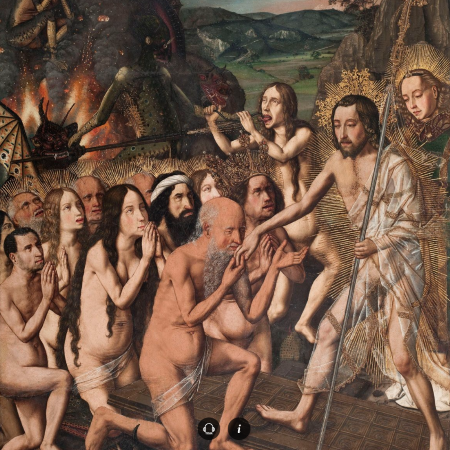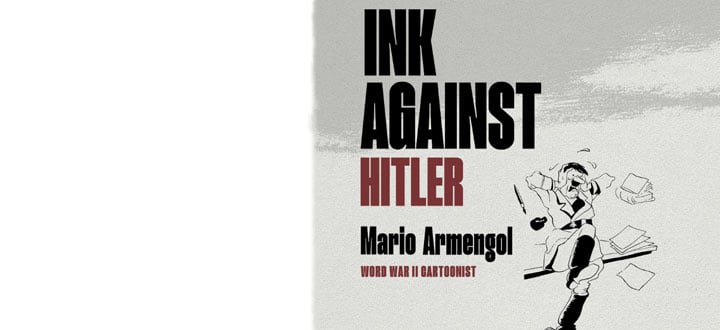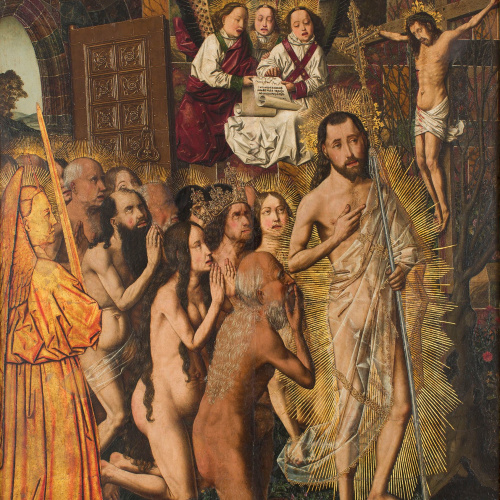The panel of the Ascencion is one of the four compartments of an altarpiece by Bartolomé Bermejo, a painter from Cordoba that developed his work known in the Corona de Aragón. Bermejo's work, characterized by a realism that has no idealisations, incorporates many of the novelties of the Nordic art, like the use of oil as binder, replacing egg tempera.All four paintings were part of the same predella dedicated to Christ the Redeemer, which has been identified as the one from a documented altarpiece by the painter, devoted to Santo Domingo de Silos (Daroca). The works were documented in Paris in 1898, in the collection of the painter Carlos Sáenz de Tejada, on whose death they were acquired by José Muñoz Ortiz, who sold them in 1914: the first two to the Museu d'Art i d'Arqueologia de Barcelona, through the mediation of Salvador Sanpere i Miquel, and the other two to Teresa Amatller i Cros, through the intervention of Josep Gudiol.The other panels of this set can also be seen at the museum: Resurrection, Descent of Christ into Limbo and Entrance into Paradise and vision of the Crucified.
The panel of the Entrance into Paradise and vision of the Crucified is one of the four compartments of an altarpiece by Bartolomé Bermejo, a painter from Cordoba that developed his work known in the Corona de Aragón. Bermejo's work, characterized by a realism that has no idealisations, incorporates many of the novelties of the Nordic art, like the use of oil as binder, replacing egg tempera.All four paintings were part of the same predella dedicated to Christ the Redeemer, which has been identified as the one from a documented altarpiece by the painter, devoted to Santo Domingo de Silos (Daroca). The works were documented in Paris in 1898, in the collection of the painter Carlos Sáenz de Tejada, on whose death they were acquired by José Muñoz Ortiz, who sold them in 1914: the first two to the Museu d'Art i d'Arqueologia de Barcelona, through the mediation of Salvador Sanpere i Miquel, and the other two to Teresa Amatller i Cros, through the intervention of Josep Gudiol.The other panels of this set can also be seen at the museum: Resurrection, Descent of Christ into Limbo and Ascension.
The panel of the Descent of Christ into Limbo is one of the four compartments of an altarpiece by Bartolomé Bermejo, a painter from Cordoba that developed his work known in the Corona de Aragón. Bermejo's work, characterized by a realism that has no idealisations, incorporates many of the novelties of the Nordic art, like the use of oil as binder, replacing egg tempera.All four paintings were part of the same predella dedicated to Christ the Redeemer, which has been identified as the one from a documented altarpiece by the painter, devoted to Santo Domingo de Silos (Daroca). The works were documented in Paris in 1898, in the collection of the painter Carlos Sáenz de Tejada, on whose death they were acquired by José Muñoz Ortiz, who sold them in 1914: the first two to the Museu d'Art i d'Arqueologia de Barcelona, through the mediation of Salvador Sanpere i Miquel, and the other two to Teresa Amatller i Cros, through the intervention of Josep Gudiol.The other panels of this set can also be seen at the museum: Resurrection, Entrance into Paradise and vision of the Crucifiedand Ascension.
El panel de la Resurrección es uno de los cuatro compartimentos de un retablo de Bartolomé Bermejo, un pintor cordobés que desarrolló su obra conocida en la Corona de Aragón. La obra de Bermejo, caracterizada por un realismo que no tiene idealizaciones, incorpora muchas de las novedades del arte nórdico, como el uso del aceite como aglutinante, que reemplaza el témpera de huevo.Las cuatro pinturas eran parte de la misma predela dedicada a Cristo Redentor, que ha sido identificada como la de un retablo documentado por el pintor, dedicado a Santo Domingo de Silos (Daroca). Las obras fueron documentadas en París en 1898, en la colección del pintor Carlos Sáenz de Tejada, a cuya muerte fueron adquiridas por José Muñoz Ortiz, quien las vendió en 1914: las dos primeras al Museo de Arte y de Arqueología. de Barcelona, a través de la mediación de Salvador Sanpere i Miquel, y los otros dos a Teresa Amatller i Cros, a través de la intervención de Josep Gudiol.Los otros paneles de este conjunto también se pueden ver en el museo: Descenso de Cristo al Limbo , Entrada al Paraíso y visión del Crucificado y la Ascensión .











![Bartolomé Bermejo - Resurrecció - Cap a 1474-1479 [1] image for: Bartolomé Bermejo - Resurrecció - Cap a 1474-1479 [1]](https://www.museunacional.cat/sites/default/files/styles/resize_500x500/public/images/art_piece/first_gallery/81705/2a._rem_renaixement-124.jpg)

![Bartolomé Bermejo - Resurrecció - Cap a 1474-1479 [1] image for: Bartolomé Bermejo - Resurrecció - Cap a 1474-1479 [1]](https://www.museunacional.cat/sites/default/files/styles/resize_500x500/public/images/art_piece/first_gallery/81703/2a._rem_renaixement-124.jpg)

![Bartolomé Bermejo - Davallament de Crist als Llimbs - Cap a 1474-1479 [1] image for: Bartolomé Bermejo - Davallament de Crist als Llimbs - Cap a 1474-1479 [1]](https://www.museunacional.cat/sites/default/files/styles/resize_500x500/public/images/art_piece/first_gallery/38452/015872-000_070622.jpg)
![Bartolomé Bermejo - Resurrecció - Cap a 1474-1479 [1] image for: Bartolomé Bermejo - Resurrecció - Cap a 1474-1479 [1]](https://www.museunacional.cat/sites/default/files/styles/resize_500x500/public/images/art_piece/first_gallery/38452/2a._rem_renaixement-124.jpg)

![Bartolomé Bermejo - Resurrecció - Cap a 1474-1479 [1] image for: Bartolomé Bermejo - Resurrecció - Cap a 1474-1479 [1]](https://www.museunacional.cat/sites/default/files/styles/resize_500x500/public/images/art_piece/first_gallery/38455/2a._rem_renaixement-124.jpg)